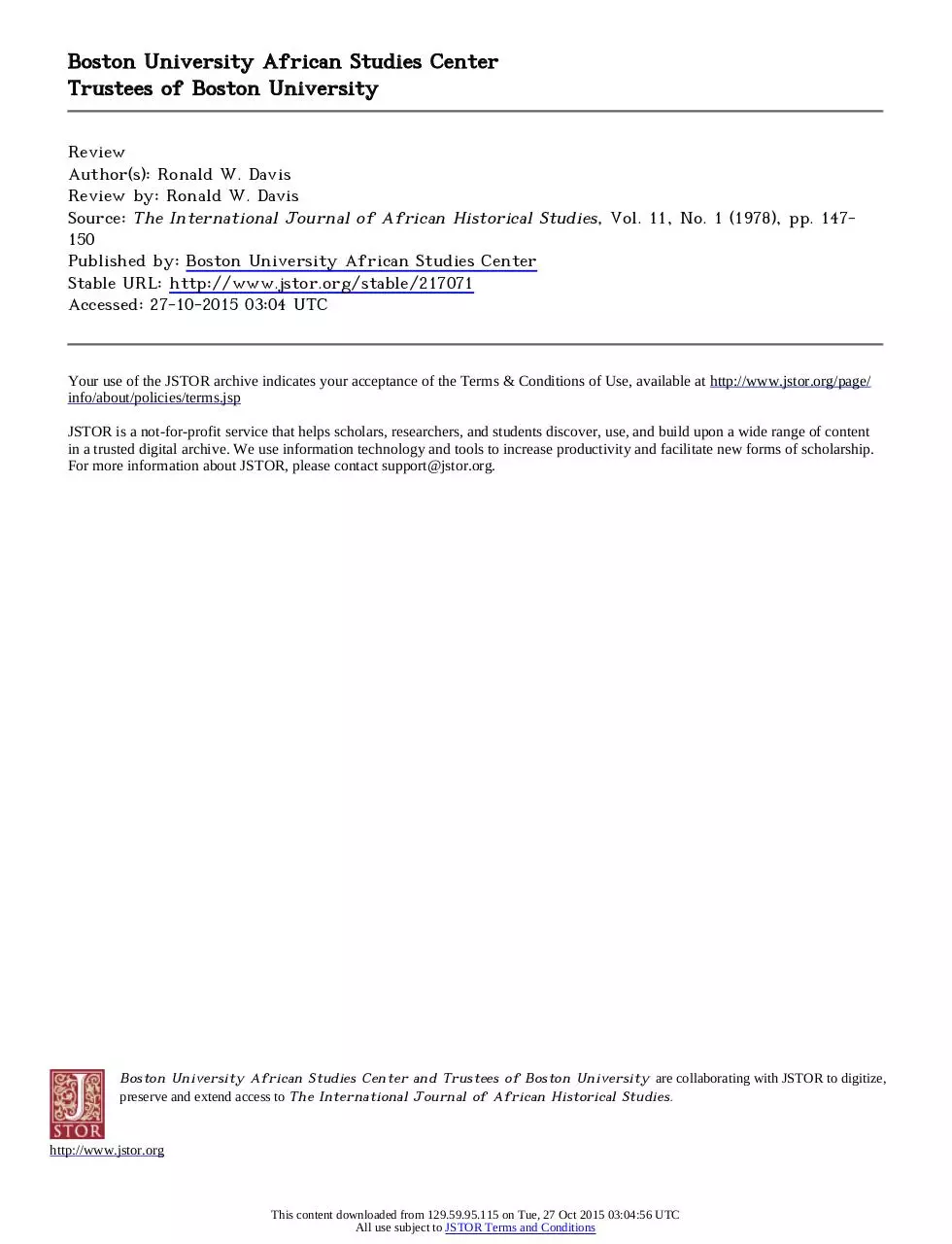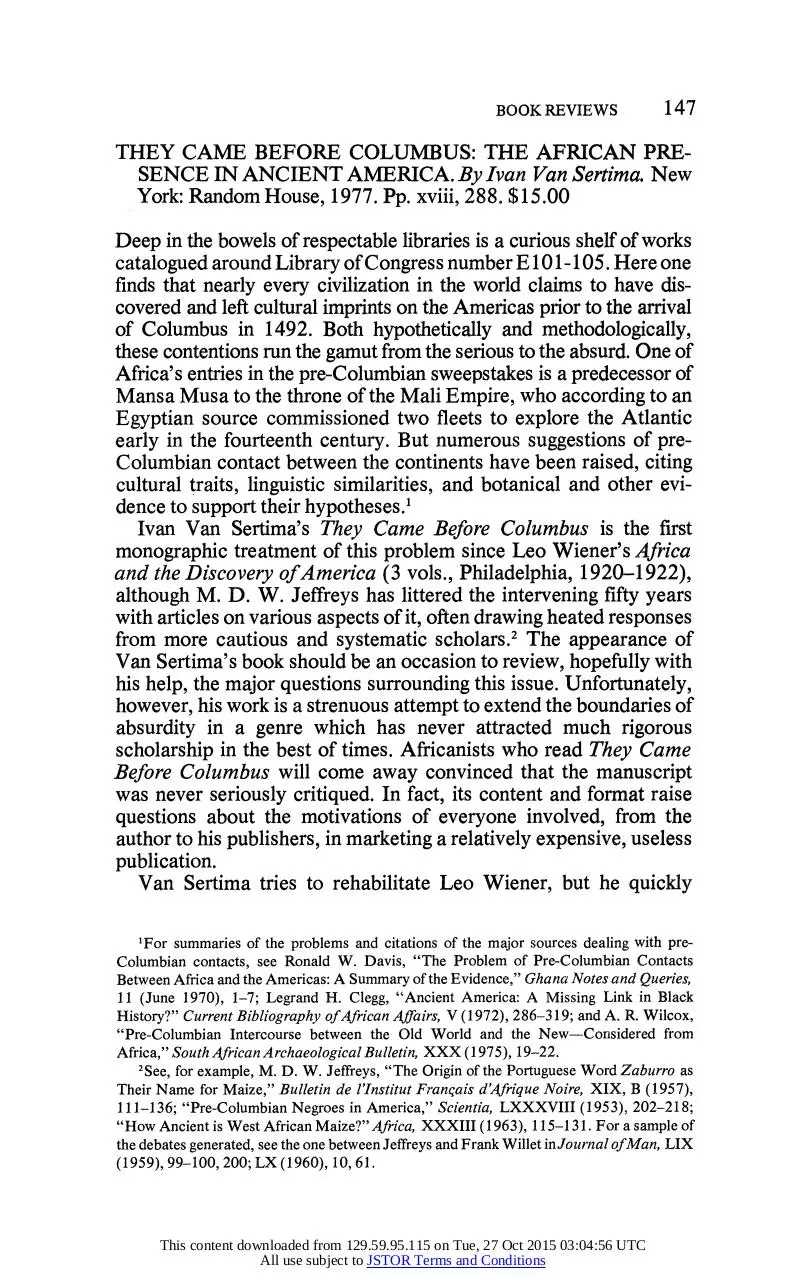217071 (PDF)
File information
This PDF 1.4 document has been generated by / iText® 5.5.5 ©2000-2014 iText Group NV (AGPL-version); modified using iText® 5.5.5 ©2000-2014 iText Group NV (AGPL-version), and has been sent on pdf-archive.com on 27/10/2015 at 05:09, from IP address 75.130.x.x.
The current document download page has been viewed 1967 times.
File size: 226.73 KB (5 pages).
Privacy: public file





File preview
Boston University African Studies Center
Trustees of Boston University
Review
Author(s): Ronald W. Davis
Review by: Ronald W. Davis
Source: The International Journal of African Historical Studies, Vol. 11, No. 1 (1978), pp. 147150
Published by: Boston University African Studies Center
Stable URL: http://www.jstor.org/stable/217071
Accessed: 27-10-2015 03:04 UTC
Your use of the JSTOR archive indicates your acceptance of the Terms & Conditions of Use, available at http://www.jstor.org/page/
info/about/policies/terms.jsp
JSTOR is a not-for-profit service that helps scholars, researchers, and students discover, use, and build upon a wide range of content
in a trusted digital archive. We use information technology and tools to increase productivity and facilitate new forms of scholarship.
For more information about JSTOR, please contact support@jstor.org.
Boston University African Studies Center and Trustees of Boston University are collaborating with JSTOR to digitize,
preserve and extend access to The International Journal of African Historical Studies.
http://www.jstor.org
This content downloaded from 129.59.95.115 on Tue, 27 Oct 2015 03:04:56 UTC
All use subject to JSTOR Terms and Conditions
BOOKREVIEWS
147
THEY CAME BEFORE COLUMBUS:THE AFRICAN PRESENCE IN ANCIENT AMERICA.By Ivan VanSertima.New
York:RandomHouse, 1977. Pp. xviii, 288. $15.00
Deep in the bowelsof respectablelibrariesis a curiousshelfof works
cataloguedaroundLibraryof CongressnumberE 101- 105. Hereone
finds that nearlyevery civilizationin the worldclaims to have discoveredandleft culturalimprintson theAmericaspriorto the arrival
of Columbusin 1492. Both hypotheticallyand methodologically,
thesecontentionsrunthe gamutfromthe seriousto the absurd.Oneof
Africa'sentriesin the pre-Columbian
sweepstakesis a predecessorof
MansaMusa to the throneof the Mali Empire,who accordingto an
Egyptiansource commissionedtwo fleets to explore the Atlantic
early in the fourteenthcentury.But numeroussuggestionsof preColumbiancontactbetweenthe continentshave been raised,citing
culturaltraits, linguisticsimilarities,and botanicaland other evidenceto supporttheirhypotheses.1
Ivan Van Sertima'sThey Came Before Columbus is the first
monographictreatmentof this problemsince Leo Wiener'sAfrica
and the DiscoveryofAmerica (3 vols., Philadelphia,1920-1922),
althoughM. D. W. Jeffreyshas litteredthe interveningfifty years
with articleson variousaspectsof it, oftendrawingheatedresponses
from more cautious and systematicscholars.2The appearanceof
Van Sertima'sbook shouldbe an occasionto review,hopefullywith
this issue. Unfortunately,
his help, the majorquestionssurrounding
however,his workis a strenuousattemptto extendthe boundariesof
absurdityin a genre which has never attractedmuch rigorous
scholarshipin the best of times. Africanistswho read They Came
Before Columbuswill come away convincedthat the manuscript
was never seriouslycritiqued.In fact, its contentand formatraise
questions about the motivationsof everyone involved, from the
authorto his publishers,in marketinga relativelyexpensive,useless
publication.
Van Sertimatries to rehabilitateLeo Wiener, but he quickly
'For summariesof the problemsand citationsof the majorsourcesdealingwith preColumbiancontacts, see Ronald W. Davis, "The Problemof Pre-ColumbianContacts
BetweenAfricaandtheAmericas:A Summaryof theEvidence,"GhanaNotesand Queries,
11 (June 1970), 1-7; LegrandH. Clegg, "AncientAmerica:A Missing Link in Black
History?"CurrentBibliographyofAfricanAffairs,V (1972), 286-319; andA. R. Wilcox,
"Pre-ColumbianIntercoursebetween the Old World and the New-Considered from
Africa,"SouthAfricanArchaeologicalBulletin,XXX(1975), 19-22.
2See,for example,M. D. W. Jeffreys,"The Originof the PortugueseWordZaburroas
TheirName for Maize,"Bulletin de l'InstitutFranqaisd'AfriqueNoire, XIX, B (1957),
111-136; "Pre-Columbian
Negroesin America,"Scientia, LXXXVIII (1953), 202-218;
"HowAncientis West AfricanMaize?"Africa,XXXIII (1963), 115-131. For a sampleof
thedebatesgenerated,see theone betweenJeffreysandFrankWilletinJournalofMan, LIX
(1959), 99-100, 200; LX(1960), 10, 61.
This content downloaded from 129.59.95.115 on Tue, 27 Oct 2015 03:04:56 UTC
All use subject to JSTOR Terms and Conditions
148
BOOKREVIEWS
departsfrom any such discerniblefocus as Wiener or the Malian
tale. The resultis a scatter-gunapproach,a naivediffusionismof the
type that once graced much of the Eurocentricworld view. Van
Sertimasimplytakes hoarynotions, such as an Egyptianstimulus
for Mesoamericanarchitecture,and appliesthe tar brush.Quetzalcoatl, for example, an Irish monk or a Welsh explorerfor other
theorists,3is black for Van Sertima(pp. 26 ff.). Spray-paintingthe
old diffusionistinterpretations,of course, is not originalwith Van
Sertima.CheikhAnta Diop and even Yosef ben-Jochanan4
display
much more sophisticatedversions of black diffusionismthan this
author,whose definitionof a "Negro-Egyptianracialtype" restson
the appearanceof a "peculiarcoiffure,facialgeographyandexpression" (p. 29). Only an argumentsuch as this could allow him to
suggestthatan Aztec god is black on the groundsthatits likenessis
sculptedin green stone with kinkyhair made of solidgold (p. 27).
And to demonstrateVan Sertima'sliberalattitudetowardthe color
bar,savorthis bit of evidenceof earlyAfro-Americancontacts:
To procurerainthe PeruvianIndianssacrificedblacksheepin a field.
The Africansof West Africa sacrificedblacksheep, blackfowl, the
bloodof blackoxen, andblackcattle.Lest it be thoughtthatthese are
naturalchoices, suggestedsimplyby the color of rainclouds ... the
Chinesedid the opposite.To ensurea good harvest... they offered
to the gods whitewild boars,whiteoxen andwhitesheepin sacrifice
(p. 86).
Inasmuchas Van Sertimaevidentlyhas no use forcarefullydating
his alleged relationships, both he and his readers sometimes find it
difficult to sort out what is indigenous to Amerindian cultures and
what might have come from trans-Atlantic contacts. After all, Van
Sertima reminds us, Amerindians themselves are descended from
"Mongols from Asia," who crossed the Bering land bridge created
when the weight of advancing glaciers buckled the earth's surface (?)
(p. 53).
Somewhat surprisingly, Van Sertima chooses to take issue with
Erich von Daniken (pp. 78 ff.), that master diffusionist of the 1970s
who has substituted extraterrestrial visitors for Caucasians and
attracted a sizable portion of the paperback budget of an entire
generation of undergraduates.5But perhaps this is understandable
3Charles Michael Boland, They All Discovered America (New York, 1961), is an entertaining account of the Quetzalcoatl theories and a number of other, standard pieces of preColumbiana.
4Cheikh Anta Diop, The African Origin of Civilization: Myth or Reality, Mercer Cook,
ed. (New York, 1974); Yosef ben-Jochanan, Black Man of the Nile (New York, 1972).
5Erichvon Daniken, Chariots ofthe Gods (New York, 1972), spawned many other books
on alleged extraterrestial stimulus for human achievements by von Daniken and many
imitators.
This content downloaded from 129.59.95.115 on Tue, 27 Oct 2015 03:04:56 UTC
All use subject to JSTOR Terms and Conditions
BOOKREVIEWS
149
for someonelike Van Sertima,whose notionof historyis obsessed
with who gets "credit"for thingspast. The idea of alien stimulito
explain "civilizations"never seems to die; only the names are
changedto protectthosewho may havebeendenigratedin an earlier
historiographicalera. Once Africans could not put two bricks
togetherwithouta Caucasianforeman.In von Daniken'sworldnonWest Europeanculturesare in stasis withoutperiodicvisits from
aliencounterpartsof theEnterprise.Van Sertimaseems obliviousto
the fact that he implicitly strips Amerindiansof their innovative
capacity in orderto satisfy his own distortedinterpretationof the
past. It may well be timeforAfricaniststo considerhow to dealwith
this kind of literature,just as scientistsrecentlyhave organizedan
offensive against astrology, the occult, pseudoscience, and their
impactson the public.
In additionto the contentof TheyCameBefore Columbus-and
this alonewill give any seriousAfricanista "peculiarcoiffure,facial
geographyand expression"-the formatof the book containssome
curiousfeatures.Nearlyhalfof it readslike a historicalnovel,mostly
in the spots whereVan Sertimacannotmusterthe evidenceneeded
to supporthis theories. Instead of a bibliography,many of his
sources are interspersedin the index, sometimes by author and
sometimesby title.Thispracticeleadsto someinterestingsequences,
suchas "Quatrefages,Alphonsede;QueenMary(ship)[lesttherebe
confusionbetween the boat and the person-in this book it could
easily be either],"followedby "Quetzalcoatl(god)." Moreover,a
list of erratainformsus that amongothertransgressionsthe nameof
Leo Wiener has been misspelled throughoutthe text, one error
among many in a carelessly preparedpublication.After such a
travestyas TheyCameBefore Columbus,RandomHouse owes the
public an apology and African studiestwo or three worksof solid
scholarship.
Van Sertimacontributesabsolutelynothingof substancetoward
the questionswhich keep the trans-Atlantictheme going. The fact
that seafarersmasteredthe Pacific and Indian oceans with relatively simplecraft,butnot the Atlantic,seemsto call foran explanation, especiallysince travelfromAfrica to SouthAmericainvolves
favorablewinds and not too great a distanceby ancient seafaring
standards.The existence of sophisticatedpolitical entities at the
Africanendof the northeasttrade-windbeltis not reallyenteredinto
the equation.As things stand, the burdenof proof must rest with
those who suggest such voyages, but with a systematic, crossculturalapproachto pre-Columbiancontactsthe suppositionthatno
trans-Atlantictraveloccurredbeforethe endof the fifteenthcentury
becomes more difficultto accept.6We need to know more of the
6Thebest collectionof such studiesto date is CarrollRiley, ed., Man across the Sea:
ProblemsofPre-ColumbianContacts(Austin,1971).
This content downloaded from 129.59.95.115 on Tue, 27 Oct 2015 03:04:56 UTC
All use subject to JSTOR Terms and Conditions
150
BOOKREVIEWS
psychologyand motivationsof exploratoryseafaring.As Van Sertima all too brieflysuggests,the tale Mansa Musa told the Egyptians contains clues about the state of Islamic cosmographical
WesternSudan.West Africans
knowledgein the fourteenth-century
here and theremay have been involvedin some of the majorproblems of Islamic geography,what with the works of scholars like
Albufeda(sic, p. 40) floatingaround.
Perhapsresearcherswill find that pre-Columbianvoyages from
the EasternHemisphereto the Americaswerenumerousbut separated by enormoustemporaland spatial gaps. If they were, they
probablyhad little effect fromany point of view. Consideringwhat
happenedto the populationsof Mexico and the Caribbeanwhen
they met small Spanishpartiesin the sixteenthcentury,a significant
impactby such voyagersmighthave left few Amerindiansto greet
Columbus when he finally washed ashore.7 Sailing across the
Atlantichas longbeen regardedas a tremendousfeat for Columbus,
andon those groundsVan Sertimaandmany otherssee still earlier
accomplishmentsas worthy of awe. Apart from his ignoranceof
the true circumferenceof the earth, a knowledgewhich restrained
wiser souls, Columbus'sonly departurefromtraditionwas to coast
southalongsideAfricabeforeturningwest acrossthe Atlantic,thus
takingadvantageof the northeasttrades and escapingthe violent
westerliesthatfrustratedPortugueseandEnglishattemptsthroughoutthe fifteenthcenturyto penetratetheAtlanticathigherlatitudes.8
The moralis that if you learnaboutthe winds and currentsthat go
whereyou wantto sail thingsgo ratherwell.
Contactsgoingthe otherway are anotherstory, but neitherVan
Sertimanor anyone else seems very interestedin possible Amerindian influenceson the Old World priorto 1492. How can you
expect the earlyAmericansto have made it across that expanseof
ocean?They couldn'teven builda respectablepyramid.
RONALDW. DAVIS
WesternMichigan University
7On the impact of Europeandisease and other factors, see Alfred W. Crosby, The
ColumbianExchange:Biological and CulturalConsequencesof 1492 (Westport,Conn.,
1972).
8SamuelEliot Morison,Portuguese Voyages to America in the Fifteenth Century
(Cambridge,Mass., 1940).
This content downloaded from 129.59.95.115 on Tue, 27 Oct 2015 03:04:56 UTC
All use subject to JSTOR Terms and Conditions
Download 217071
217071.pdf (PDF, 226.73 KB)
Download PDF
Share this file on social networks
Link to this page
Permanent link
Use the permanent link to the download page to share your document on Facebook, Twitter, LinkedIn, or directly with a contact by e-Mail, Messenger, Whatsapp, Line..
Short link
Use the short link to share your document on Twitter or by text message (SMS)
HTML Code
Copy the following HTML code to share your document on a Website or Blog
QR Code to this page

This file has been shared publicly by a user of PDF Archive.
Document ID: 0000310709.